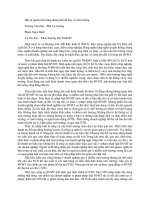Job evaluation hay group
Bạn đang xem bản rút gọn của tài liệu. Xem và tải ngay bản đầy đủ của tài liệu tại đây (528.21 KB, 61 trang )
Introduction to Job Evaluation
THP Group
April 2010
Typical Issues
“Our group is
different”
“We are
treated as
second class”
Employee has
been with us
a long time
Employee
performed
very well
Increased
work volume
or more
difficult
© 2008 Hay Group. All Rights Reserved
1. Diagnose
2. Alternatives
3. Solutions
Employee has
great potential
for growth
2
Choosing the right solution
Redesign
work for clear
value creation
Core Principles
- Creating value not just
creating more work
Sustainable for
company and the
individual
Reinforcing outstanding
Develop career
and not just fix
the job
Understand &
communicate
consistently
performance and not
just doing the minimum
requirements
Realign
performance
indicators
Select
differently
Evaluate Job
© 2008 Hay Group. All Rights Reserved
Incentivize
differently
3
01
Hay Guide Chart®Profile
Method of Job Evaluation
Hay Guide Chart®Profile Method of Job
Evaluation
Developed by Edward N. Hay in the early 1940’s.
Modified over the years to reflect the changing needs and evolution of
organizations.
Most widely used process for the evaluation of management, professional
and technical jobs in the world.
Used by more than 4,000 organizations in over thirty countries.
© 2008 Hay Group. All Rights Reserved
5
Basic Premise
We must first believe that all jobs exist to contribute in some way to the
organization.
Job evaluation allows us to measure the contributions of jobs in terms
of internal value and further enables linking these internal values to
external market data.
Hay Group methodology measures three aspects of a job:
Knowledge required (input)
Problem Solving involved (throughput)
Results expected (output)
The outcome of this methodology is a measurement of job size in terms
of points.
© 2008 Hay Group. All Rights Reserved
6
Factors Used in the Hay Group Method
The jobholder requires
To achieve this
Jobs exist to
end result, jobholders must
achieve an
address problems,create, analyze
end result
and apply judgment.
Để hoàn tất kết quả này người nắm
Công việc tồn
giữ chức vụ phải xác định được vấn
Tại để hoàn thành
đề, thiết lập phân tích và ra quyết
1 Kết Qủa
định
Knowledge and experience
consistent with the scale and
complexity of the result to be
achieved/ Người nắm giữ công
việc yêu cầu phải có kiến thức
và kinh nghiệm phù hợp với
độ lớn và độ khó của kết quả cần thực hiện
Know-How
+
Problem Solving
+
Accountability
Accountability
Problem Solving
+
Accountability
The Hay Group method uses three universal compensable elements to measure the relative
size of jobs/ Phương pháp Hay Group sử dụng 3 yếu tố trả lương phổ quát để đo độ lớn
của các công việc
KnowHow Factor
To achieve results, jobs must require a certain level of knowledge, skills
and experience. Để hoàn thành kết quả, công việc phải yêu cầu 1 mức độ về kiến
thức, kỹ năng và kinh nghiệm nào đó.
Know-How is the factor we use to measure the sum total of knowledge required of
a job, however gained. Know-How là yếu tố sử dụng để đo tổng số kiến thức được
yêu cầu của 1 công việc, bằng cách nào đó đạt được.
Know-How has three dimensions/Know-How có ba chiều:
Practical/Technical Knowledge/ Kiến thức chuyên môn
Planning, Organizing, Integrating (Managerial) Knowledge/các kiến thức về Hoạch định,
tổ chức, điều hợp (thuộc về quản lý)
Communicating and Influencing Skills/ Các kỹ năng giao tiếp và gây ảnh hưởng
The Knowledge Required of a Job or “Input”
8
Problem Solving Factor
©
2008
Hay
In utilizing Know-How to achieve results, jobs are designed to analyze and resolveGroup
problems. Để sử dụng Know-How cho việc hoàn tất kết quả, công việc được thiết
. All
lập để phân tích và xử lý vấn đề.
Reser
Problem Solving is the factor we use to measure the nature and complexity of the
problems and challenges that jobs must face.Problem solving là yếu tố sử dụng để
đo lường bản chất và sự phức tạp của các vấn đề và thách thức mà công việc phải
đương đầu.
Problem Solving has two dimensions/Problem solving có 2 chiều:
Thinking Environment – Freedom to Think/ Môi trường suy nghĩ – Sự tự do để suy nghĩ
Thinking Challenge/ Suy nghĩ thách thức
Rights
ved
Accountability Factor
Based on the premise that all jobs exist to achieve results. Dựa trên tiền đề rằng
tất cả các công việc hiện hữu để tạo ra các kết quả.
Accountability is the factor we use to measure the output of jobs. Accountability
là yếu tố sử dụng để đo lường đầu ra của công việc.
Accountability has three dimensions. Accountability có 3 chiều
Freedom to Act/ Tự do hành động
Nature of Impact/ Bản chất của sự tác động
Magnitude (Area of Impact)/ Tầm quan trọng (Phạm vi ảnh hưởng)
The Accountability or
“Output” of a Job
10
02
Hay Guide Chart Factors/Bảng hướng dẫn các yếu tố tính điểm
Know How Factor
KnowHow
Sum total of every kind of capability, however acquired, necessary for competent
job performance. Tổng số của các loại năng lực, đạt được bằng cách nào đó cần
thiết để đạt thành tích của công việc yêu cầu.
Know-How can be acquired through/ Know-How có được thông qua:
Formal education – engineering, finance, law, medicine, etc./ Giáo dục thông thường: Kỹ
sư, tài chính, luật,y khoa, vv…
Education and experience – programming, skilled trades, etc./ Giáo duc và kinh nghiệm:
Lập trình, thương mại kỹ năng, vv…
Experience – sales, supervision, etc./ Kinh nghiệm – Bán hàng,giám sát, vv…
Know-How has three dimensions/Know-How có 3 chiều như sau:
Practical/Technical Knowledge/ Kiến thức thực hành/ chuyên môn
Planning, Organizing, Integrating (Managerial) Knowledge/Kiến thức hoạch định, tổ
chức, phối hợp (quản lý)
Communicating and Influencing Skills/ Kỹ giao tiếp và gây ảnh hưởng
Practical/Technical Knowledge
t
Depth & Breadth/ Chiều rộng và chiều sâu
© 2008 Hay Group. All Rights Reserved
13
Operati on s Man agemen t
Marke tin g
Fin an ce
PR
HR
Purch asi n g
Dist ribu tion
Adver tisi n g
Sal es Tech niqu es
Marke Dev el opmen t
Products
Mainten an ce
Purch asi n g
En gin eerin g
Cardiolo g y
Stan dard Costs
Evaluating Practical/Technical
Knowledge
A – Basic/ Cơ Bản
Simple procedures, detailed instructions and routine operations/
Qui trình đơn giản, hướng dẫn chi tiết và các hoạt động thường nhật.
May involve use of simple equipments/
Có thể sử dụng các thiết bị giản đơn
Positive habits for individual and team efforts
Những thói quen rõ ràng cho các nỗ lực cá nhân và nhóm.
Able to perform basic math operations (add, subtract)/
Có thể thực hiện các phép toán đơn giản.
14
Mail room clerk, file clerk, assembler, and Laborer
Các công việc như: nhân viên tạp vụ, lưu hồ sơ, thợ lắp ráp, lao động pt…
Evaluating Practical/Technical
Knowledge
B – Introductory/ Dẫn nhập
Basic abilities in understanding established, standardized instructions, ability to utilize
basic equipment, math skills (able to work with percentages, fractions and decimals)
Những khả năng cơ bản trong sự hiểu biết về các hướng dẫn được chuẩn hóa, thiết
lập, có khả năng sử dụng các công cụ, khả năng tính toán cơ bản (có thể làm việc
với tỷ lệ %, hàm số và thập phân)
Typical of what high school education plus some skills training (clerical accounting,
secretarial, electronics, drafting)
Điển hình là tốt nghiệp PTTH cộng thêm một số lớp kỹ năng (kế toán, thư ký, điện tử,
thiết kế…)
Receptionist, data entry, maintenance helper, assembler, truck drive, guard,
accounting clerk, unskilled to semiskilled production.
Các công việc như: Tiếp tân, nhập dữ liệu, hỗ trợ bảo trì, thợ lắp ráp, tài xế xe tải,
bảo vệ, kế toán viên, công nhân sản xuất kỹ thuật và công nhân phổ thông.
© 2008 Hay Group. All Rights Reserved
E
v
aluating Practical/Technical
Knowledge
C- General/ Process/ Procedure/ Thông thường/Qui trình
Procedural or systematic proficiency in use of somewhat diversified procedures and
precedents; may involve facility in operation of specialized equipment of moderate
Complexity
Thành thạo về hệ thống hay qui trình trong việc sử dụng những quy trình và thông lệ
có phần đa dạng hơn; có thể liên quan đến khả năng thông thạo trong việc vận hành
các thiết bị chuyên môn ở mức độ phức tạp trung bình.
“Journey” level of skill in vocational areas. Mức độ kỹ năng ở cấp độ trường nghề
Secretary, accounting clerk, bank teller, computer operator, customer service clerk,
drafter (CAD), carpenter, painter, journey level operations and craft skills
Các công việc thư ký, kế toán viên,thu ngân, nhân viên dịch vụ khách hàng, nhân
viên đồ họa, thợ mộc, thợ sơn, các công việc vận hành đơn giản và các kỹ năng về
thủ công.
15
Evaluating Practical/Technical
Knowledge
D – Advanced/ Nâng Cao
Specialized knowledge (nontheoretical) utilizing substantially diversified standards and
precedents; may involve operation of equipment with significant complexity. Typically
highest level of technical knowhow for work classified as “nonexempt.”
Có Kiến thức chuyên môn hóa (không đơn thuần lý thuyết) sử dụng những thông lệ và
tiêu chuẩn đa dạng một cách bền vững; có thể liên quan đến việc vận hành các máy
móc có mức độ phức tạp cao.
Computer programmer, technician, industrial nurse, customer service representative,
maintenance electrician, tool and die maker, highly skilled to master level trade, first line
supervisor.
Lập trình viên, kỹ thuật viên, y tá, đại diện DVKH, thợ tạo rập, khuôn đúc, nhân viên kinh
doanh mức độ từ có kỹ năng tới chuyên nghiệp, giám sát sản xuất.
E – Professional/ Chuyên nghiệp
Basic understanding and application of clearly defined policies and principles,defined work
practices, precedents, theoretical or scientific theory and functional principles. Understanding
of why things are done is important.
Có hiểu biết và thực hành cơ bản về các nguyên tắc, chính sách được xác định rõ ràng, các
thực hành công việc, thông lệ, lý thuyết hoặc khoa học và các nguyên tắc chức năng xác định.
Hiểu biết về tầm quan trọng các việc được thực hiện.
Levels of difficulty/abstraction typically gained through a four year college degree program.
Mức độ khó/trừu tượng thông thường có được qua chương trình 4 năm đại học.
Entry and learning levels of individual contributor positions in the professions (e.g., accounting,
legal, engineering, etc.), first line to midlevel supervisor/managers, technical sales positions.
Mức độ dẫn nhập/học hỏi của cá nhân vị trí trong các nghề nghiệp (vd: Kế toán, pháp lý, kỹ
sư, vv…), Giám sát/quản lý cấp cơ sở tới cấp trung, các vị trí bán hàng kỹ thuật.
F – Seasoned Professional/ Chuyên nghiệp cao
Proficiency in application of knowledge in a broad, multifunctional field, or considerable depth
and seasoning in a technical and specialized field. Thông thạo trong việc áp dụng kiến thức trong
một lĩnh vực rộng, đa chức năng,hoặc sâu sắc đáng kể trong một lĩnh vực kỹ thuật và chuyên môn 16
hóa.
Typical career top out level of technical knowhow for professionals.
Nghề nghiệp điển hình cao hơn hẳn cấp bậc Know how của các chuyên môn.
Evaluating Practical/Technical
Knowledge









